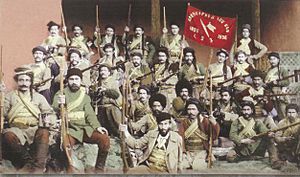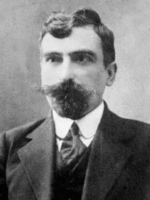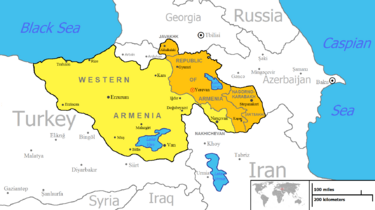Armenian Revolutionary Federation facts for kids
Quick facts for kids
Armenian Revolutionary Federation
Հայ Յեղափոխական Դաշնակցութիւն
|
|
|---|---|
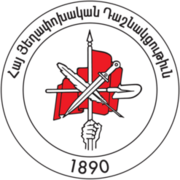 |
|
| Other name | Dashnaktsutyun |
| Abbreviation | ARF (English) ՀՅԴ (Armenian) |
| Bureau Chairman | Hakob Ter-Khachaturyan |
| Supreme Council Chairman |
Ishkhan Saghatelyan |
| Founders | Christapor Mikaelian Stepan Zorian Simon Zavarian |
| Founded | 1890 in Tiflis, Russian Empire (now Tbilisi, Georgia) |
| Headquarters | Hanrapetutyun Street 30, Yerevan |
| Newspaper | Yerkir (Երկիր, "Country") and Droshak (Դրօշակ, "Banner") |
| Student wing | ARF Shant Student Association ARF Armen Karo Student Association |
| Youth wing | Armenian Youth Federation |
| TV Channel | Yerkir Media (in Armenia) |
| Membership (2012) | 6,800 (in Armenia only) |
| Ideology |
|
| Political position | Center-left to left-wing |
| National affiliation | Homeland Salvation Movement (in Armenia; 2020–2021) Armenia Alliance (in Armenia) March 8 Alliance (in Lebanon) |
| European affiliation | Party of European Socialists (observer) |
| Continental affiliation | Forum of Socialists of the CIS Countries |
| International affiliation | Socialist International (1951–1960; 1996–present) Labour and Socialist International (1923–1940) Second International (1907–1916) |
| Colors | Red and gold |
| Slogan | "Ազատութիւն կամ մահ" Azatut'yun kam mah ("Freedom or Death") |
| Anthem | "Մշակ, բանուոր" Mshak Banvor ("Peasant and Worker") |
| Affiliates | Armenian Relief Society Homenetmen Hamazkayin Armenian National Committee of America |
| National Assembly of Armenia |
10 / 107
|
| National Assembly of Artsakh |
0 / 33
|
| Parliament of Lebanon |
3 / 128
|
| Party flag | |
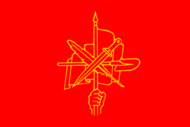 |
|
|
^ a: United Armenia is an irredentist concept referring to areas within the traditional Armenian homeland. The ARF idea of "United Armenia" incorporates claims to Western Armenia (eastern Turkey), Nagorno-Karabakh (Artsakh), the landlocked exclave Nakhichevan of Azerbaijan and the Javakheti (Javakhk) region of Georgia. |
|
The Armenian Revolutionary Federation (ARF), also known as Dashnaktsutyun, is an Armenian political party. It was founded in 1890 in Tiflis, which was then part of the Russian Empire and is now Tbilisi, Georgia. The party was started by Christapor Mikaelian, Stepan Zorian, and Simon Zavarian.
The ARF is known for supporting Armenian nationalism and socialist ideas. It aims to protect Armenian interests and culture. As of 2023, the party is active in Armenia, Lebanon, Iran, and in many countries where Armenians live around the world. It was also active in Artsakh until September 2023.
The ARF has been very important in the Armenian diaspora (Armenians living outside Armenia). It has a smaller presence in modern Armenia compared to its influence abroad. Currently, the party has ten seats in the National Assembly of Armenia and three seats in the Parliament of Lebanon.
The ARF has always supported socialist democracy. It has been a full member of the Socialist International since 2003, an organization of socialist political parties worldwide. The party works to get the Armenian genocide recognized by other countries and seeks fair compensation for the Armenian people. It also supports the idea of a "United Armenia," which would include traditional Armenian lands.
Contents
A Look at the ARF's Beginnings
The Armenian Revolutionary Federation started when different Armenian political groups came together. Their main goal was to achieve "political and economic freedom" for Armenians living in what was then called Turkish Armenia. They planned to do this through armed resistance.
In the 1890s, the ARF worked to unite smaller groups in the Ottoman Empire. These groups were trying to bring about changes and protect Armenian villages from attacks and violence. ARF members formed groups of fighters called fedayi who defended Armenian civilians.
The party avoided revolutionary actions in the Russian Empire until 1903. This was when Russian authorities decided to take control of Armenian Church property. The ARF saw this as a threat to Armenian identity and strongly opposed it.
Originally, the ARF only asked for self-rule and democratic rights for Armenians in both the Ottoman and Russian Empires. However, in 1919, they changed their goal to creating an independent and united Armenia.
In 1918, the ARF played a key role in forming the Democratic Republic of Armenia. This republic lasted until 1920 when it was taken over by Soviet communists. After their leaders were exiled, the ARF continued its work in Armenian communities around the world. They helped Armenians keep their culture and identity alive.
After the Soviet Union broke apart in 1991, the ARF was able to return to Armenia. The party was part of the government for some time. However, after the 2018 "Velvet Revolution," the ARF lost public support in Armenia. In the 2018 elections, they did not win enough votes to have seats in the parliament.
During the 2020–2021 protests in Armenia, the ARF joined the "Armenia Alliance." This alliance, led by former President Robert Kocharyan, won 29 seats in the National Assembly in the 2021 election.
Early Days in the Russian Empire
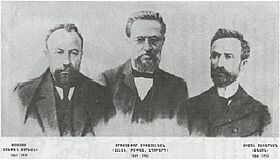
In the late 1800s, many small groups in the Russian Empire wanted to see changes in Armenian areas of the Ottoman Empire. In 1890, Christapor Mikaelian, Simon Zavarian, and Stepan Zorian created the "Federation of Armenian Revolutionaries" to unite these groups. This party later became known as the "Armenian Revolutionary Federation" or "Dashnaktsutiun."
The ARF quickly gained support among Armenians in Russia. The Russian government initially supported the ARF because their goals against the Ottoman Empire were similar. However, this changed in 1903 when the Russian government tried to take control of Armenian Church property. The ARF strongly opposed this, seeing it as a threat to Armenian identity. They organized protests and sent fighters to protect Armenian churches.
From 1905 to 1906, violence broke out between Armenians and Tatars. The ARF became involved in defending Armenians. They believed the Russian authorities were not doing enough to stop the violence. The ARF argued that they were helping to protect Armenian people from attacks. During this time, the ARF believed that armed actions were sometimes needed to achieve their political goals.
The ARF in the Persian Empire

In 1907, the Dashnaktsutiun held a meeting to discuss their involvement in the Iranian Constitutional Revolution. They decided that this movement was important for establishing law, order, and human rights for all people, including Armenians living in Iran.
From 1907 to 1908, Armenians from different regions worked with Iranian revolutionaries. The Dashnaktsutiun wanted to help guide the revolution towards more democracy. They sent some of their well-known fedayees (fighters) to Iran. A key ARF member already in Iran was Yeprem Khan, who had started a branch of the party there. Yeprem Khan was very important in the Iranian Constitutional Revolution. He worked with other revolutionary leaders to fight against the Shah's government. The ARF and Yeprem Khan achieved several victories, including taking over the city of Rasht in 1909.
The Ottoman Empire Years
Protecting Armenians (1894–1908)
The ARF became a powerful force in Armenian life, especially in the Ottoman Empire. They organized and took part in many revolutionary activities. They were good at teaching people and gaining support for their political goals.
For example, in 1894, the ARF helped the people of Sasun defend themselves against attacks by the Ottoman government. They supplied weapons to the local population. In 1896, the ARF helped defend the city of Van from attacks.
To bring attention to the massacres of Armenians in 1895–96, ARF members took over the Ottoman Bank in 1896. Their goal was to demand reforms for Armenians in the Ottoman Empire and get European countries to notice their cause. This action did get Europe's attention.
Many famous Armenian thinkers and writers joined the ARF during this time. In 1897, the ARF carried out the Khanasor Expedition against a Kurdish tribe that had attacked Armenian defenders. Many Armenians see this as their first victory over the Ottoman Empire.
In 1904, the ARF played a big role in the Second Sasun Uprising. They sent weapons and fedayi fighters to defend the region. Even though they were outnumbered, they held off the Ottoman army for several months.
In 1905, ARF members organized a failed attempt to assassinate Sultan Abdul Hamid II in Constantinople (now Istanbul).
Working with the Young Turks (1908–1914)
The ARF and a group called the Committee of Union and Progress (Young Turks) both wanted to overthrow Sultan Abdul Hamid II. In 1907, the ARF agreed to work with the Young Turks, hoping that if they came to power, Armenians would gain more self-rule.

In 1908, Sultan Abdul Hamid II was overthrown. The ARF became a legal political party, and Armenians gained more seats in parliament. However, the reforms were not as much as the ARF had hoped for. After the Adana massacre in 1909, relations between Armenians and Turks worsened, and the ARF ended its alliance with the Young Turks in 1912.
World War I and the Armenian Genocide
In 1915, many ARF leaders and other Armenian intellectuals were arrested and killed by Ottoman officials. This was part of a terrible event known as the Armenian genocide. The ARF, however, continued to fight for a "Free, Independent, and United Armenia." They led the defense of the Armenian people during this time.
One important event was the Van Resistance. The Ottoman governor of Van ordered all Armenians to be killed. About 30,000 Armenians in Van, joined by others from nearby villages, fought back. The battle started on April 20, 1915, led by ARF leader Aram Manukian. It lasted for two months. In May, Armenian and Russian forces entered the city and drove out the Ottoman army. The ARF also helped with other resistance movements in different areas.
After World War I, members of the Young Turks movement, who were seen as responsible for the Armenian genocide, were brought to justice by the ARF in a secret operation called Operation Nemesis.
The First Republic of Armenia (1918–1920)
After the Russian Empire collapsed in 1917, Armenian, Georgian, and Azerbaijani leaders in the Caucasus formed the Transcaucasian Federation. This federation lasted only three months. Then, the Republics of Armenia, Georgia, and Azerbaijan were created. ARF members were the negotiators for Armenia.
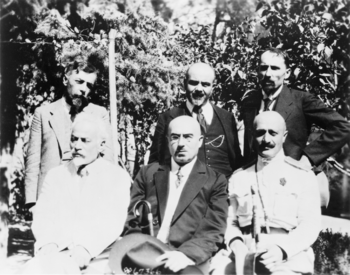
Sitting: Avetik Sahakyan, Alexander Khatisyan, General Christophor Araratov. Standing: Nikol Aghbalian, Abraham Gyulkhandanyan, S. Araradian.
When the Transcaucasian Federation fell apart, Armenians had to defend themselves as the Turkish army approached their capital, Yerevan. The ARF decided not to surrender and fought the Turkish army. On May 28, 1918, the Armenian army won a major victory at the Battle of Sardarapat, stopping the Turkish forces.
The Democratic Republic of Armenia was declared on the same day, and the ARF became the ruling party. However, the new country faced huge challenges, including a broken economy, many refugees, and widespread hunger.
The ARF had a strong presence in the new Armenian government, holding many important positions. The republic struggled with conflicts and economic problems. In 1920, the situation worsened, and Armenia was isolated. After losing a war with Turkey, Armenia signed a treaty that resulted in losing large territories. Soon after, Soviet Red Army troops invaded, and the ARF government gave up power. The ARF was banned, its leaders were exiled, and many members scattered around the world.
The ARF in Exile
After the communists took control of Armenia, the ARF moved its operations to where Armenians had settled outside their homeland. They built strong political groups in places like Lebanon and Syria. From 1921 to 1990, the Dashnaktsutiun created political structures in over 200 countries, including the USA, where many Armenians lived.
During this time, there were also divisions within the Armenian Church. Some Armenians in the US believed that Moscow was trying to use the Armenian Church to spread communist ideas. This led to the Armenian Church splitting into two branches. The ARF supported the branch that was separate from the one in Soviet Armenia.
During World War II, some ARF members in Berlin hoped to free Armenia from Soviet control by supporting the Nazis. The Armenian Legion, made up of former Soviet prisoners of war, fought in the Crimean Peninsula.
In the 1950s, the ARF and the Armenian Soviet Socialist Republic had disagreements. This led to more conflict within Armenian communities, especially in Lebanon. The ARF continued to support a "Free, Independent, and United Armenia," free from both Soviet and Turkish control.
The ARF in Lebanon
| Year | Mandates | ||
|---|---|---|---|
| 1943 |
1 / 55
|
||
| 1947 |
2 / 55
|
||
| 1951 |
2 / 77
|
||
| 1953 |
1 / 44
|
||
| 1957 |
2 / 66
|
||
| 1960 |
4 / 99
|
||
| 1964 |
4 / 99
|
||
| 1968 |
4 / 99
|
||
| 1972 |
1 / 99
|
||
| 1992 |
1 / 128
|
||
| 1996 |
1 / 128
|
||
| 2000 |
2 / 128
|
||
| 2005 |
2 / 128
|
||
| 2009 |
3 / 128
|
||
| 2018 |
3 / 128
|
||
| 2022 |
3 / 128
|
||
From 1923 to 1958, Armenian political parties in the diaspora had conflicts over leadership. The ARF and other parties sometimes clashed. In 1956, a disagreement within the Armenian Church further divided the Armenian community in Lebanon. This led to some armed conflicts between supporters and opponents of the ARF.
Before the Lebanese Civil War (1975–1990), the ARF worked closely with another political party in Lebanon. However, the ARF and most Armenian groups chose not to take an active part in the civil war. This caused problems with their allies, and Armenian areas were attacked. Many Armenians linked to the ARF took up arms to defend their neighborhoods.
Armenians in Lebanon have six seats in the country's parliament. The ARF branch in Lebanon has usually won most of these seats. In the 2009 elections, the ARF won two seats. In 2011, ARF members were appointed to two government minister positions.
The ARF Lebanon branch has its main office in Bourj Hammoud. It also runs the Aztag Daily newspaper and the "Voice Of Van" radio station.
Independent Armenia and the ARF
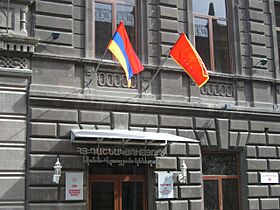
The ARF has always believed in a "Free, Independent, and United Armenia." This idea of "United Armenia" includes territories mentioned in the Treaty of Sèvres, as well as Artsakh, Javakhk, and Nakhichevan.
When Armenia gained independence in 1991, the ARF became one of the main political parties. However, in 1994, the President of Armenia, Levon Ter-Petrosyan, banned the ARF. He claimed the party was involved in terrorism and trying to overthrow the government. Many ARF leaders were arrested, and their offices were closed. Human rights groups and the opposition believed these actions were politically motivated.
The ban on the ARF was lifted in 1998 after Ter-Petrosyan left power. Most ARF members who had been arrested were released.
In 2007, the ARF had a cooperation agreement with the ruling government. With 16 out of 131 seats, the ARF was the third-largest party in Armenia's parliament. ARF members also led several government ministries, including Agriculture, Education, Labor, and Healthcare. In 2007, the ARF History Museum opened in Yerevan, showing the party's history.
In 2008, the ARF nominated its own candidate for president, Vahan Hovhannisyan, who came in fourth place. The ARF later rejoined the ruling government. However, in 2009, the ARF left the government and became an opposition party again. In the 2012 parliamentary election, the ARF won 5 seats.
The ARF rejoined the government in 2016, getting three ministerial positions. After the 2016 Nagorno-Karabakh clashes, the ARF helped Armenia's Ministry of Defense create a volunteer battalion, mostly made up of party members. This unit, called the "ARF battalion," includes experienced soldiers.
In the 2017 elections, the party won 7 seats. However, after the 2018 "Velvet Revolution," the ARF broke its alliance with the ruling party and moved into opposition. In the 2018 election, the ARF only got 3.89% of the votes, which was below the 5% needed to get seats in parliament. This was the first time since Armenia's independence that the ARF had no political representation in the National Assembly.
Since then, the ARF has become a main opposition party outside of parliament. They have also increased their social aid programs, especially in rural areas of Armenia. During the 2020 COVID-19 pandemic, the party provided help to locals, thanks to donations from Armenians living abroad.
During the 2020 Nagorno-Karabakh War, the ARF again formed volunteer battalions to fight. After the war, the party joined a group of 16 other political parties called the "Homeland Salvation Movement." They called for the Prime Minister to resign after Armenia's defeat in the war.
In the 2021 snap parliamentary election, the ARF formed the Armenia Alliance with former president Robert Kocharyan. This alliance won 29 seats, with 10 of them taken by ARF candidates.
ARF in Artsakh
After the Soviet Union took control of the South Caucasus, it created the Nagorno-Karabakh Autonomous Oblast (NKAO) within the Azerbaijan SSR in 1923. In the last years of the Soviet Union, the ARF started a branch in Nagorno-Karabakh.
In January 1991, the Dashnaktsutiun won the parliamentary election and was the ruling party during the entire First Nagorno-Karabakh War. The Dashnaks strongly supported the independence of Nagorno-Karabakh (which Armenians call Artsakh). They helped the Nagorno-Karabakh Defense Army by sending volunteers and providing weapons, food, and medicine. The party even had its own infantry battalion, the "Shushi independent battalion," which was very effective during the war.
The ARF continued to be involved in Artsakh's politics. In the June 2005 elections, the Dashnaktsutiun was part of an alliance that won 3 out of 33 seats. In the March 2020 elections, the party won 3 seats in the National Assembly.
What the ARF Believes and Aims For
The founders of the Armenian Revolutionary Federation were nationalists and socialists. The party's first program, called "General Theory," included many Marxist ideas. The ARF has always aimed to change the government and gain more rights for Armenians through revolution and armed struggle.
The ARF still includes socialism in its political beliefs. Its program covers the Armenian revolutionary movement's goals for national freedom, political change, and social-economic improvements. The ARF supports a parliamentary republican political system.
The main goals of the ARF are:
- To create a free, independent, and united Armenia. This "United Armenia" would include all lands identified as Armenia by the Treaty of Sèvres, as well as Artsakh, Javakhk, and Nakhichevan.
- To get countries around the world to recognize the Armenian genocide committed by the Ottoman Empire. They also seek the return of occupied lands and fair compensation for the Armenian nation.
- To bring Armenians living all over the world back to the lands of United Armenia.
- To make Armenia's government stronger, establish democracy and the rule of law, ensure people's economic well-being, and create social justice in a democratic and socialist independent republic.
In 1907, the Dashnaktsutiun joined the Second International, an organization of socialist parties. They later joined the reformed Socialist International in 1996 and became a full member in 1999.
A member of the ARF is called Dashnaktsakan or Tashnagtsagan. Members formally call each other Comrade (Unger for boys and men, Ungerouhi for girls and women).
The party has supported some policies that favor Armenia's closer ties with the European Union. However, in 2013, the ARF supported Armenia joining the Eurasian Economic Union instead of signing an agreement with the EU. They stated this was due to "security concerns." In 2016, the ARF signed a cooperation agreement with a European social-democratic group.
Groups Connected to the ARF
The ARF is seen as a leading organization for Armenians living outside Armenia. It has created many Armenian schools, community centers, sports groups, relief societies, youth groups, and other organizations worldwide.
The ARF also works with other important Armenian community groups like the Armenian Relief Society, the Homenetmen Armenian General Athletic Union, and the Hamazkayin Cultural Foundation. It runs the Armenian Youth Federation, which encourages young Armenians to get involved in the ARF's political goals.
The ARF Shant Student Association and the ARF Armen Karo Student Association are groups for college and university students.
In the US and Canada
The Armenian National Committee of America is a strong Armenian advocacy group in the United States that is connected to the ARF. Its sister organization, the Armenian National Committee of Canada, is also very influential in Canada.
In Other Countries
Branches of the Armenian National Committee in many other countries, including Argentina, Australia, France, Greece, and Lebanon, have played a big role in getting the Armenian genocide recognized in their countries.
Media Outlets
The ARF and its connected organizations around the world publish 12 newspapers (4 daily, 8 weekly). They also have two TV channels, including one online, and two radio stations, one of which is online.
- Periodicals
| Name (in Armenian) | Type | Date est. | Location | Language(s) | Website |
|---|---|---|---|---|---|
| Yerkir (Երկիր) | weekly | 1991 | Eastern Armenian | ||
| Aparaj (Ապառաժ) | weekly | Eastern Armenian | |||
| Alik (Ալիք) | daily | 1931 | Eastern Armenian | ||
| Housaper (Յուսաբեր) | daily | 1913 | Western Armenian | ||
| Aztag (Ազդակ) | daily | 1927 | Western Armenian | ||
| Hairenik (Հայրենիք) | weekly | 1899 | Western Armenian | ||
| Armenian Weekly | weekly | 1934 | English | ||
| Haytoug (Հայդուկ) | youth magazine (AYF) | 1978 | Western Armenian, English | ||
| Horizon (Հորիզոն) | weekly | 1979 | Western Armenian, English, French | ||
| Ardziv (Արծիւ) | youth magazine (AYF) | 1991 | Western Armenian, English, French | ||
| Artsakank (Արձագանգ) | weekly | Western Armenian, English | |||
| Azat Or (Ազատ Օր) | weekly | 1945 | Western Armenian, Greek | ||
| Kantsasar (Գանձասար) | weekly | 1978 | Western Armenian | ||
| Armenia (Արմենիա) | weekly | 1931 | Western Armenian, Spanish | ||
| ARFWest.org | online | 2020 | Eastern and Western Armenian, English | ARFWest.org | |
| Oragark | online | 2022 | English, Eastern and Western Armenian | Oragark.com |
- Television
| Name | Date established | Location | Language(s) | Website |
|---|---|---|---|---|
| Yerkir Media (Երկիր Մեդիա) | 2003 | Armenian | ||
| Nor Hai Horizon TV | 1993 | Armenian, English |
- Radio
See Also
 In Spanish: Federación Revolucionaria Armenia para niños
In Spanish: Federación Revolucionaria Armenia para niños
- Armenian national movement
- Armenian fedayees
- Armenian Revolutionary Federation in Lebanon
- ARF History Museum


